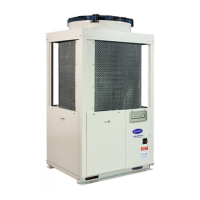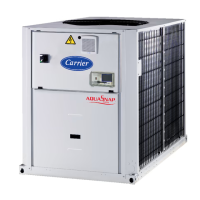30RB/30RQ
GB - 12
Start-up, compressor and pump replacement, unit protection devices
Start-up
Unit start-up is done by the electronic control described above, and
must always be carried out under the supervision of a quali ed air
conditioning engineer.
Necessary checks/precautions before start-up
- Ensure that all electrical connections are properly tightened.
- Ensure that the unit is level and well-supported.
- Check that the hydraulic circuit has su cient water ow and that the
pipe connections correspond to the installation diagram.
- Ensure that there are no water losses. Check the correct operation of
the valves installed.
- All panels should be tted and rmly secured with the corresponding
screws.
- Make sure that there is su cient space for servicing and maintenance
purposes.
- Ensure that there are no refrigerant leaks.
- Con rm that the electrical power source agrees with the unit
nameplate rating, wiring diagram and other documentation for the
unit.
- Ensure that the power supply corresponds to the applicable standards.
- Make sure that compressors oat freely on the mounting springs.
Compressor replacement
As the compressors are hermetic, when an internal fault occurs, the
compressor must be replaced.
This must be done as detailed below:
- Disconnect the unit from the electrical supply.
- Remove the access panels.
- Remove the gas from the refrigerant circuit using recovery equipment
to avoid harming the atmosphere.
- Electrically disconnect the compressor.
- Unbraze or unscrew the suction and discharge lines, taking care not to
damage the rest of the components.
- Remove the compressor fastenings.
- Replace the compressor, ensuring that it contains su cient oil.
- Braze or screw in the lines.
- Connect the compressor according to the wiring diagram.
- Evacuate the compressor.
- Introduce the quantity of refrigerant indicated on the nameplate
through the service couplings located on the high and low pressure
side.
NOTE:
This operation must be carried out by a quali ed person.
Pump replacement
If the water pump needs to be replaced, proceed as follows:
- Disconnect the unit from the power supply.
- Open/remove the access panel/s
- Electrically disconnect the pump.
- Empty all water from the hydronic module.
- Loosen the pipe unions a and c.
- Remove the four pump xing screws b.
- Replace the pump.
- Fit the pump xing screws b.
- Tighten the pipe unions a and c.
- Electrically connect the pump
- Connect the unit to the power supply
- Make sure the pump rotates in the right direction using the hole in the
back panel.
- Reinstall the lateral access panel.
Description of unit protection devices
The unit includes the following protection devices:
- Internal compressor protection.
- Fan motor internal thermal protection.
- Main switch.
- Anti-short-cycle protection.
- Thermomagnetic main switch.
- Thermomagnetic control switch
- Fan circuit breaker, heaters and compressor.
- Defrost thermostat.
- Fault detector for the temperature and pressure sensors.
- High pressurestat: this protects the unit against excessive condensing
pressure.
The high pressurestat has factory- xed non-adjustable settings. The
appliance stops due to the intervention of the high pressure alarm
threshold, before the high pressurestat intervenes.
This function is performed by the electronic control device via a
pressure transducer.
- Low pressurestat: This function is performed by the electronic control
device via a pressure transducer.
Only on appliances with hydronic module
- Pump motor external thermal protection.
1
2
3
1 pipe union
2 screw
3 pipe union

